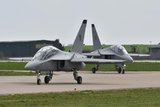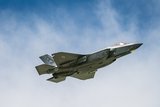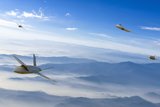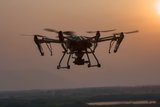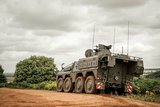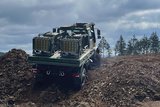AW149: Designed to Survive the Modern Battlefield (Sponsored)
This article is brought to you by Leonardo
From the earliest stages of its development, the AW149 was designed with the safety and security of battlefield troops in mind. To achieve this, Leonardo’s design philosophy adopts a ‘Survivability Onion’ approach. This article will discuss how the AW149 has survivability at its core.
▶️ WATCH: AW149 - The Modern Battlefield Platform
Avoid Loss of Life
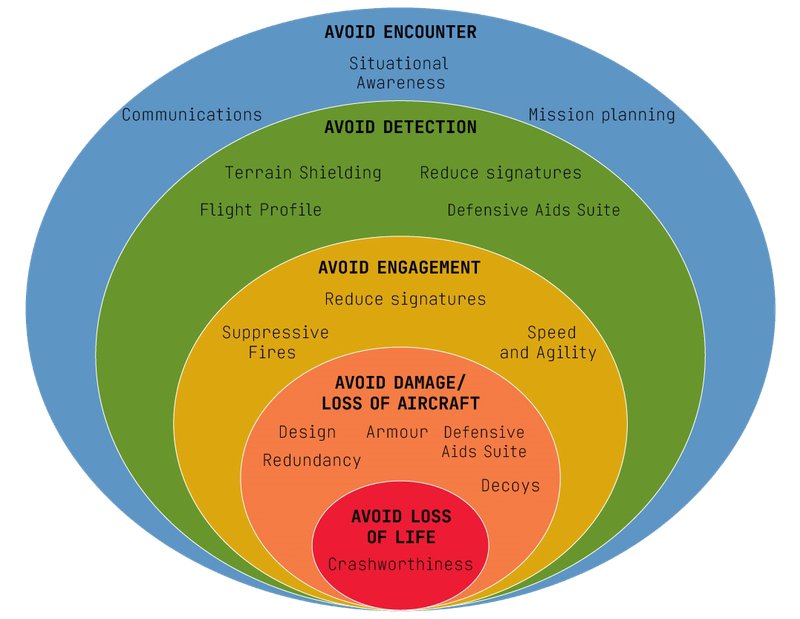
Leonardo considers the ‘Survivability Onion’ from the inside out, this has ensured that the AW149 is designed from the outset to meet the exacting crashworthiness standards required by the UK Ministry of Defence (MOD). To achieve this, a high fidelity ‘Digital Twin’ was used at the AW149 design stage, simulating the effects of different crash cases, including the benchmark vertical crash case. In doing so, Leonardo was able to evaluate the airframe structure of the AW149 – which remained intact during simulation protecting crew and cabin occupants and enabling safe egress.
These simulations were then compared with an actual observed behaviour crash test that saw a fuel cell dropped from 50 feet. This test correlated at high levels with simulation results, as well as a robust airframe, the AW149 fuel tanks and fuel cut-off features are also designed to prevent fire in the event of a crash, further increasing survivability.
As Mike Overd, Chief Engineer for UK Military Aircraft, explains: “It’s an important factor to remember that 95% of all survivable crashes are going to be less severe than this vertical crash case, so we have a very high confidence level that the occupants can survive the vast majority of crashes.”
Avoid Loss of Aircraft
In addition to high levels of crashworthiness, the AW149 is a platform with very low vulnerability. It has an outstanding ability to withstand enemy fire and avoid damage, which is similarly considered in the design process. The AW149 boasts excellent redundancy of its critical systems, which are separated from one another on the platform to minimise the risk of them being disabled from small arms fire. Leonardo has also designed self-sealing fuel tanks and ballistic protection solutions for the cabin and cockpit, in addition to the main and tail rotors.

Vulnerability software was used to achieve this. Mike states: “During the initial design […] we simulated the aircraft behaviour using the same modelling techniques used by UK MOD.” Leonardo’s analysis demonstrated that AW149’s blades can withstand 12.7mm armour-piercing incendiary bullets – not just the tailing edge, but damage to the load bearing spar.
Furthermore, residual strength tests show that in the event of damage, AW149 blades can withstand the strain of a full mission profile for over 90 minutes and still be able to land safely. Likewise, all gearboxes can continue to operate at cruise flight power after oil loss for up to 50 minutes. This reflects 100 nautical miles of flight, giving crew an increased envelope to land in a friendly zone.
Avoid Detection & Engagement
Alongside its robust airframe, the AW149 platform is equipped with systems to help avoid detection in hostile environments and engagement with threats such as Man-Portable Air Defence Systems (MANPADS).These weapons are a great threat to military helicopters, and can be fired from almost anywhere with high lethality.
Leonardo has worked with colleagues at Davis Engineering to develop a new infrared (IR) suppression system to overcome such threats. IR suppression reduces the range at which an IR missile can detect and lock onto the aircraft, and improves the effectiveness of aircraft countermeasures. Mark Burnand, Chief Test Pilot at Leonardo Helicopters UK, says, “We’ve recorded over 35 test and evaluation flying hours with this installation on-board the AW149 and the results have been really impressive, delivering a 75% reduction in Band IV IR signature recognition, at all azimuth and elevation angles around the aircraft. This reduction is of vital importance when it comes to reducing vulnerability from heat-seeking missiles, because Band IV IR is the wavelength that these missiles typically lock onto.”

The AW149 is also currently fitted with a Leonardo Defensive Aids System (DAS), which works to provide measures in avoiding detection and engagement on an increasingly modern battlefield. These include a radar warning receiver, a missile warning sensor, a laser warning receiver and chaff and flare.
The current timeline for the UK MOD’s New Medium Helicopter requirement presents an opportunity to expand upon these DAS capabilities. Work is already underway with Leonardo’s Electronic Warfare experts in Luton to develop next generation DAS for the AW149.
While some elements of survivability can be improved with the addition of role-fit mission equipment, the AW149 was designed from the outset to survive in modern theatre and is battle ready.
More from Industry Spotlights
-
![The future is here: Sixth-gen air dominance]()
The future is here: Sixth-gen air dominance
How RTX is equipping the military airspace – for today’s fleet and tomorrow’s fight.
-
![De-Risking the Future: Manufacturing Certainty for Unmanned Systems]()
De-Risking the Future: Manufacturing Certainty for Unmanned Systems
How strategic manufacturing partnership solves the industrialisation triad — Scale, Compliance and Cost — for hyper-growth defence tech innovators.
-
![Battlefield mobility, made in the UK]()
Battlefield mobility, made in the UK
How does Britain ensure that we can preserve the lives of our soldiers and allies – now and in the future – with homegrown innovation and resilient domestic manufacturing? At Pearson Engineering, we are proud to be a central part of the answer to this increasingly important question.
-
![Strengthening Baltic defence capabilities]()
Strengthening Baltic defence capabilities
How Latvia is bolstering its territorial defences, industrial capacity and international cooperation with Dynamit Nobel Defence’s SKORPION2 Remote Mining System.
-
![Barco’s vision to trust: from past to future]()
Barco’s vision to trust: from past to future
Barco’s story is one of constant evolution enabling more immersive, reliable, and future-ready training experiences.
-
![How are next-generation ejection seats helping pilots when they need it most?]()
How are next-generation ejection seats helping pilots when they need it most?
The ACES 5 ejection seat from RTX’s Collins Aerospace introduces new, innovative and patented technologies to help save lives.








